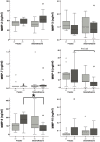Dexamethasone, cerebrospinal fluid matrix metalloproteinase concentrations and clinical outcomes in tuberculous meningitis
- PMID: 19789647
- PMCID: PMC2748711
- DOI: 10.1371/journal.pone.0007277
Dexamethasone, cerebrospinal fluid matrix metalloproteinase concentrations and clinical outcomes in tuberculous meningitis
Abstract
Background: Adjunctive dexamethasone reduces mortality from tuberculous meningitis, but how it produces this effect is not known. Matrix metalloproteinases (MMPs) are important in the immunopathology of many inflammatory CNS diseases thus we hypothesized that that their secretion is important in TBM and might be influenced by dexamethasone.
Methodology/principal findings: The kinetics of cerebrospinal fluid (CSF) MMP and tissue inhibitors of MMPs (TIMPs) concentrations were studied in a subset of HIV uninfected adults (n = 37) with TBM recruited to a randomized, placebo-controlled trial of adjuvant dexamethasone. Analysis followed a pre-defined plan. Dexamethasone significantly reduced CSF MMP-9 concentrations in early follow up samples (median 5 days (range 3-8) of treatment), but had no significant influence on other MMPs/TIMPs. Additionally CSF MMP-9 concentration was strongly correlated to concomitant CSF neutrophil count.
Conclusions/significance: Dexamethasone decreased CSF MMP-9 concentrations early in treatment and this may represent one mechanism by which corticosteroids improve outcome in TBM. The strong correlation between CSF MMP-9 and neutrophil count suggests that polymorphonuclear leukocytes may play a central role in the early pathogenesis of TBM.
Conflict of interest statement
Figures



References
-
- Thwaites GE, Nguyen DB, Nguyen HD, Hoang TQ, Do TT, et al. Dexamethasone for the treatment of tuberculous meningitis in adolescents and adults. N Engl J Med. 2004;351:1741–1751. - PubMed
-
- Simmons CP, Thwaites GE, Quyen NT, Chau TT, Mai PP, et al. The clinical benefit of adjunctive dexamethasone in tuberculous meningitis is not associated with measurable attenuation of peripheral or local immune responses. J Immunol. 2005;175:579–590. - PubMed
-
- Schoeman JF, Elshof JW, Laubscher JA, Janse van Rensburg A, Donald PR. The effect of adjuvant steroid treatment on serial cerebrospinal fluid changes in tuberculous meningitis. Ann Trop Paediatr. 2001;21:299–305. - PubMed
-
- McGeer PL, McGeer EG. Inflammation of the brain in Alzheimer's disease: implications for therapy. J Leukoc Biol. 1999;65:409–415. - PubMed
Publication types
MeSH terms
Substances
Grants and funding
LinkOut - more resources
Full Text Sources
Miscellaneous

